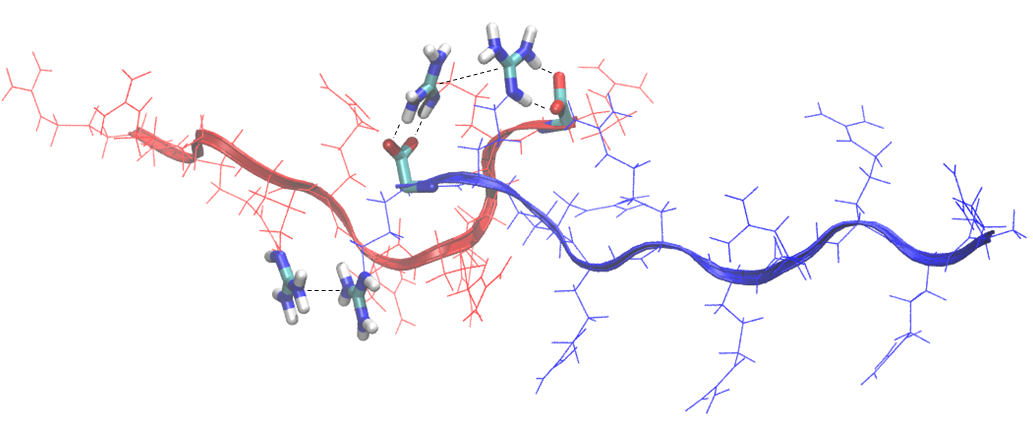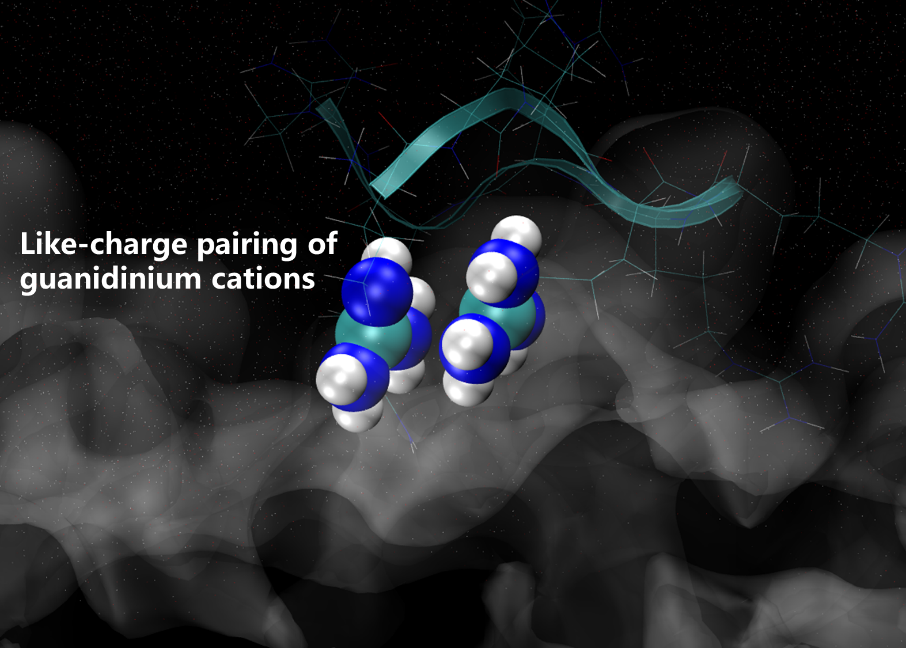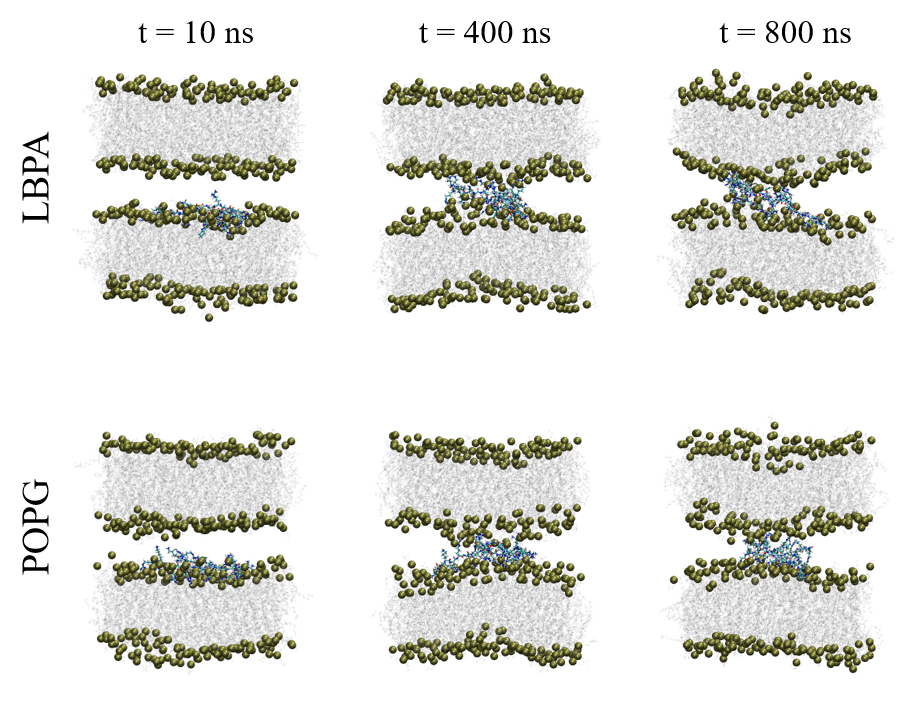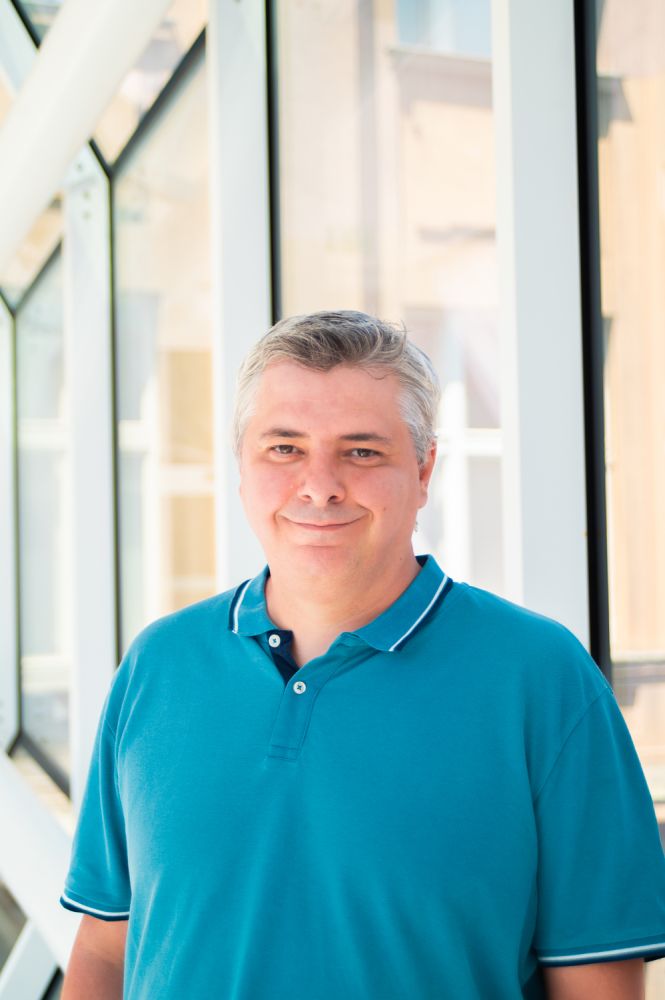Welcome to the Molecular Modeling and Simulation Group! We are a newly formed group at the Department of Mathematics at Faculty of Chemical Engineering, University of Chemistry in Prague.
Our focus is molecular modeling and simulations of different systems, from physical chemistry of the simplest biological systems like water to various chemical processes in important biological systems, such as biological membranes and membrane proteins.
We are using different computational methods, including classical mathematical modeling, quantum chemical calculations to molecular dynamics simulations, always in combination with different experimental techniques, such as FT-IR, Raman, NMR and UV spectroscopy in collaboration with many experimental groups in Czechia and around the world.
Bachelor and master students are always welcome!
A couple of snapshots showing what we are doing:
Self-association of a highly charged arginine-rich cell-penetrating peptide
Positively charged particles are mutually repelled from each other according to the Coulomb law. However, in solvents with high dielectric constant (such as water), and in some special situations it is possible that repulsion counterintuitive converts to attraction between like-charged particles. Using molecular dynamics simulations and complementary SAXS and NMR experiments, we showed that two positively charged deca-arginines (R10) associate in water.

G. Tesei, M. Vazdar, M. Ringkjøbing Jensen, C. Cragnell, P. E. Mason, J. Heyda, M. Skepö, P. Jungwirth, M. Lund, Proceedings of the National Academy of Sciences of the United States of America, 114 (2017), 11428-11433
Arginine “Magic”: Guanidinium Like-Charge Ion Pairing from Aqueous Salts to Cell Penetrating Peptides
Guanidinium (Gdm+) cation is a pivotal moiety in arginine amino acid. Due to its structural and electronic properties, Gdm+ cations make like-charge pairs, which in turn has important consequences in numerous properties, ranging from formation of small Gdm+ clusters to cell penetration of arginine rich cell penetration peptides.

M. Vazdar, J. Heyda, P. E. Mason, G. Tesei, C. Allolio, M. Lund, P. Jungwirth, Accounts of chemical research, 51 (2018), 1455-1464
Mechanism of Cell Penetration by Permeabilization of Late Endosomes: Interplay between a Multivalent TAT Peptide and Bis(monoacylglycero)phosphate
Arginine rich peptides are used frequently as compounds which penetrate through cell membranes and are often used for pharmaceutical purposes. In collaboration with cell biologists and with help of molecular dynamic simulations, we proposed the mechanism how cell penetrating peptides permeate across endosomes, in turn reaching cellular interior.

D. J. Brock, H. Kondow-McConaghy, J. Allen, Z. Brkljača, L. Kustigian, M. Jiang, J. Zhang, H. Rye, M. Vazdar, Jean-Philippe Pellois, Cell Chemical Biology, 27 (2020), 1296-1307

Contact persons:
Y Dr. Mario Vazdar
b Mario.Vazdar@vscht.cz
e 22044 3160
Y Dr. Jaroslav Schmidt
b Jaroslav.Schmidt@vscht.cz
Y Dr. Eliška Rezlerová
b Eliska.Rezlerova@vscht.cz
Collaborators:
- Dr. Jan Heyda, UCT, Prague
- Prof. Pavel Jungwirth, IOCB, Prague
- Prof. Lukasz Cwiklik, Heyrovsky institute, Prague
- Prof. Elena Pohl, University of Veterinary medicine, Vienna
- Prof. Mikael Lund, Lund University, Sweden
- Dr. Danijela Bakaric, Rudjer Boskovic Institute, Zagreb
- Prof. Paul S. Cremer, Penn State University, USA
- Prof. Jean-Phillipe Pellois, Texas A&M University, USA
Selected publications:
- D. J. Brock, H. Kondow-McConaghy, J. Allen, Z. Brkljača, L. Kustigian, M. Jiang, J. Zhang, H. Rye, M. Vazdar, Jean-Philippe Pellois, Cell Chemical Biology, 27 (2020), 1296-1307 (journal impact factor = 7.739)
- O. Jovanović, S. Škulj, E.E. Pohl, M. Vazdar, Free Radical Biology and Medicine, 143 (2019), 433-440 (journal impact factor = 5.657)
- . Vazdar, J. Heyda, P. E. Mason, G. Tesei, C. Allolio, M. Lund, P. Jungwirth, Accounts of chemical research, 51 (2018), 1455-1464 (journal impact factor = 20.955)
- G. Tesei, M. Vazdar, M. Ringkjøbing Jensen, C. Cragnell, P. E. Mason, J. Heyda, M. Skepö, P. Jungwirth, M. Lund, Proceedings of the National Academy of Sciences of the United States of America, 114 (2017), 11428-11433 (journal impact factor = 9.504)
- L. Artiglia, J. Edebeli, F. Orlando, S. Chen, M.-T. Lee, P. Corral-Arroyo, A. Gilgen, T. Bartels-Rausch, A. Kleibert, M. Vazdar, M. Carignano, J. S. Francisco, P. B. Shepson, I. Gladich, M. Ammann, Nature Communications, 8 (2017), 700-1 (journal impact factor = 12.353)
